
by Gustaf Westerlund | Apr 22, 2015
 |
| You have to decide… |
Did you know that Putin has a summer house in Florida?
Vaccines make you sick!
To change base currency in CRM, just run this script, there is no risk!
The Internet is full of bad information. Ever found something on a blog on Internet and tried it? A script, some code or something else that you really didn’t know what it did. Could you really trust the source?
I have met customers and sometimes even partners who mention that “Well I found a solution to this very complex problem XX, you just run this script YY on the CRM database, it was on a blog on Internet. Like a blog on Internet, like this one is some oracle of truth. I am sorry to break it to you, but this is not so. Just as with everything else you see and hear on the Internet, you need to be critical about the information, and judge it and the source where it is coming from. In the end, it is you who are responsible for what you are doing with the CRM system. If you happen to run a script that is bad, install a auto numbering solution that causes masses amounts of locking or copy paste an unsupported script into the onload of the account form, it is still your responsibility. Hence I recommend that you do not run or insert anything that you do not fully understand or have gotten from a source that you feel that you can trust has verified the contents.
If you don’t know it, the Dynamics CRM SDK page on unsupported customizations is a really good page to start with. If something you find, is listed here, you should really think again. Remember that the current cadance of CRM is very rapid, you cannot afford to have a system that is not upgradable or on which you cannot get support if you get into big problems.
https://msdn.microsoft.com/en-us/library/gg328350.aspx#Unsupported
With that said, there is a great and wonderful community out there with a lot of great and wonderful tools and advice, so don’t stop using it, just be a bit critical.
So, who am I to say this. A very good question. If you feel this question is relevant, and question the validity of this argument, I think you have gotten the point.
Gustaf Westerlund
MVP, Founder and CTO at CRM-konsulterna AB
www.crmkonsulterna.se

by Gustaf Westerlund | Apr 21, 2015
”The new CRM was nice but there were some bugs and Excel is still so much easier, so I just went back to it.”
This is the 8:th part in the series on using Dr. John Kotters 8 step method for implementing new CRM systems in an organization. We have now gotten as far as the system being accepted by users and that they have started using it.
During and just after the initial implementation of the new CRM system users are often good sports and give it a shot, and there might also be strong ambassadors in the people that were driving the implementation. This can often result in the fact that users use the system to a decent level in the beginning.
Managers are also often quite diligent in the beginning of a system implementation to make sure that their employees use the system.
However, the strong driving people might change role or move to Other companies. It is not uncommon that these people are more entreprenuerial and creators than the people who are good at maintaining a system. So, they move on to other projects and tasks. Managers will also get other priorities on their tables, often making the CRM system, not as important.
 |
| Keep up the pressure |
Other common things that I have seen are that the system might also have some bugs and quirks that might not have showed up in the implementation phase or might have surfaced during later upgrades and these might or might not be surfaced to the people responsible for the CRM system. If not quickly rectified, the risk is substantial that users will revert to their previous manner of working, or some other easy way of managing their own productivity. This is most commonly using Excel to, for instance, keep track of which leads have been contacted.
Dr. Kotter emphezises in this chapter that it is important to constantly reinvigorate the change, in this case the new CRM system with new updates. For instance, making sure that you listen to the suggestions and problems that users are experiencing and acting on these. The passionate ambassadors for change can also be used in this phase to energize the rest of the workforce. Also measuring the use in the system, to make sure that users actually are using it, is important, so that you do not think that they are when it fact they are finding other ways to store information. If left without action for too long, you risk large problems with trying to get user back on track. This is especially true and complicated in large and distributed organizations when you cannot physically monitor what users actually are doing by looking over their shoulders. If team managers are also part of the problems, or perhaps managers in even higher levels, the problems are naturally of even higher magnitude.
Gustaf Westerlund
MVP, CTO and Founder at CRM-konsulterna AB
www.crmkonsulterna.se
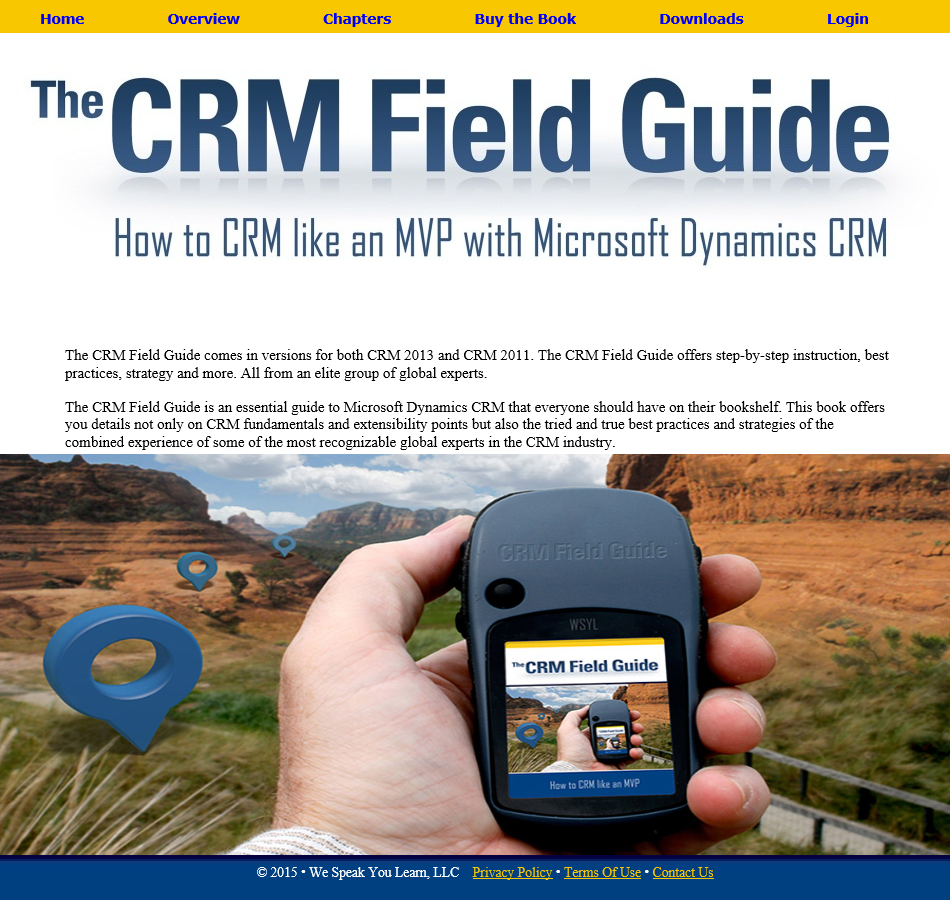
by Gustaf Westerlund | Apr 21, 2015
After a lot of work a huge amount of MVP:s have now managed to achieve the second CRM Field Guide. I have this time had the honor of being among the authors of this very comprehensive title which goes into details of many areas that very few other books do. At almost 1000 pages it is something that you just have to have with you if you are a CRM expert, or claiming to be one. As Bob Stutz, said in his keynote here at eXtreme CRM today, it is impossible to keep all this information in the head, so we have helped you out, we have tried to destill it poured it into this book.
The book is for CRM 2013, which might seem strange, now that CRM 2015 Update 1 is about to be released but keeping up with Microsoft’s cadance is not easy. The absolut majority of the things in the book are still true, yes, there might be some new features in CRM 2015 that can be revised in the book, but I guarantee you that if you know the book by heart, you will be one of the best experts in the worlds on Dynamics CRM, even CRM 2015.
And from our perspectives as authors, most of us, like me, are CTO:s, Techical directors, CEO:s, or senior consultants and developers, we take a lot of our time to write this book, as we partly like to share our knowledge, and partly, I guess to be totally truthful, to feed our pride a bit :). However, the CRM market for books is very limited, and the time frame a book is current is very short, making piles and piles of money off a CRM book is almost impossible, it is probably better to go about your daily job. I would hence say that the best way that you can encourage us to write the next version of this book, is to tell us, the people who made it what you thought of it. What is good, what can be made better? Tell us what is useful for you when you are working with a customer, tell us what you lack. The more people showing interest in what we do, the more we feel inclined to make the next version.
To buy your copy, click on the image below. I have 25 discount vouchers, to my readers, so the first 25 people can use the code “Gustaf2013”.
Gustaf Westerlund
MVP, Founder and CTO at CRM-konsulterna AB
www.crmkonsulterna.se
by Gustaf Westerlund | Apr 19, 2015
I was recently contracted by Microsoft Sweden to hold two custom certification preparation classes for the MB2-704 Microsoft Dynamics CRM Application and MB2-707 Microsoft Dynamics CRM Customization and Configuration.
One of the things that struck me during the preparation of this course was that Microsoft have changed the names of the certifications. Previous certifications, for instance the matching certification for CRM 2013 Application is named “MB2-700 Microsoft Dynamics CRM 2013 Application”. For those who need it to be spelled out, the version name is no longer in the name of the certification…”
As Microsoft have at the same time moved all Microsoft Official Curriculum Courses (MOC) from being normal classroom Courses to being eLearning Courses, one might wonder if there might be a significant pattern here.
The last but not least piece of the puzzel, is the now increased version cadance, one new version for CRM Online every 6 months and a new major version for both CRM Online and On-premise every year.
My conclusion is, that the version number indicates that they might be sticking to this for some time. Creating, and maintaining new certificates probably takes a lot of Resources from their end so this might be a way to manage the current version cadance.
A related subject is that for Dynamics NAV, all certifications have been dropped. There are no new certifications for NAV 2015 and the requirements for partners are being revised. I don’t Think this will spill over to Dynamics CRM, but it is none the less interesting.
I also tried taking the new MB2-707-OP, Online Proctored version of the exam, but I didn’t even get to Writing the certification as my full formal name is “Nils Gustaf Westerlund” and this is also what my ID says. However, the “Nils” part is never used and is for instance not on any of my credit cards. I had hence not used “Nils Gustaf” as my first name in the Microsoft account either and I have never had any issues with this earlier when Writing exams at any of the test centers, and I wanted to test the online proctored exam so that I could tell the attendees of the class I was holding about it so that they could know if it was useful or not. As you probably could imagine from my elaborations regarding my name, when I had to show my ID to the supervisor of the exam, I was informed that my name was wrong. I tried explaining that this is how names are written in Sweden, and even showed him several of my credit cards with Master Card, showing only “Gustaf Westerlund” but that did not help. He was about as flexible as a piece of Concrete. After a lot of complaining and phone calls to Pearson Vue, I finally got them to pay me back. I can only imagine the kind of trouble you can have if you have a Chinese or Russian name. I strongly suggest that Pearson Vue shape up their understanding of international naming standards. I signed up for a test at a local test center the day after and there was no problem there but I am Always flabbergasted at what I am not good at based on the test, this time it was forms. If anything, I am actually quite good at forms, and I do teach CRM 1.2 (not so much any more), 3.0, 4.0, 2013, 2015 and have worked with CRM for 10 years. But I passed, and I guess that is what counts.
Now, I have to go to bed, tomorrow is Innovation Challange here in Madrid, eXtreme CRM! I hope you are here, don’t be a stranger! I don’t bite.
Don’t miss George Doubinski’s and my “7 Sins of CRM Development” on Tuesday at 11:00 in room Bangkok if you are here in Madrid.
Gustaf Westerlund
MVP, CEO and owner at CRM-konsulterna AB
www.crmkonsulterna.se
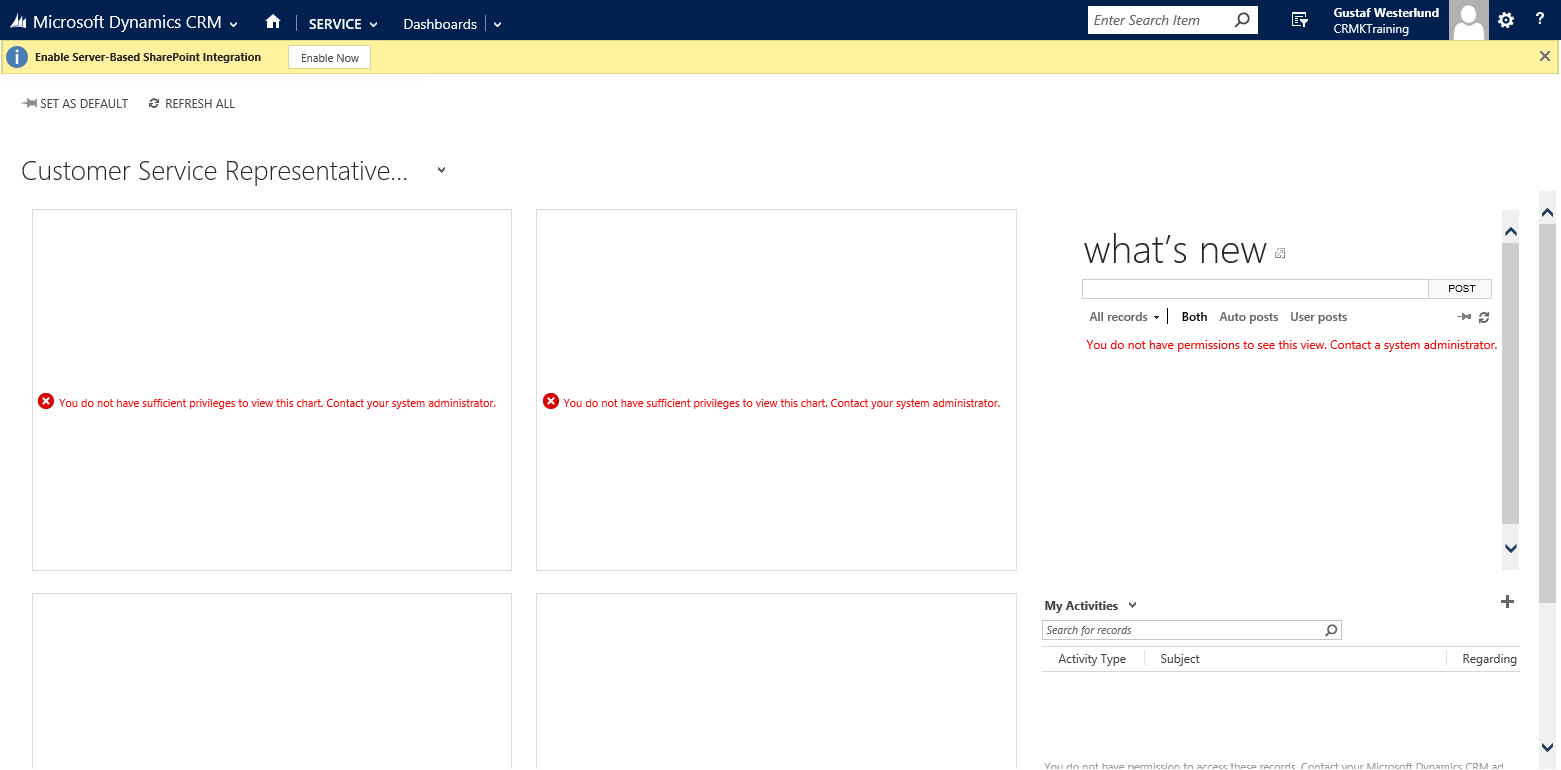
by Gustaf Westerlund | Apr 13, 2015
As some of you might have noticed when setting up a new Dynamics CRM Online 2015, for instance a 30 day trial, which can be done on this link, you will now see a much more limited view than before.
This is due to the fact that the default Access mode of the user that is created when the CRM instance is set up to “Administrative” not “Read-Write” as it used to be. The point of this is that it is not to use a license unless necessary.
To change it, go to the new location of user in Settings->Security->Users
The first thing we have to do is to assign a license to the user from the O365 portal. So click the link in the top information part of the user form to navigate there directly.
This will take you to the O365 provisioning, where you can assign a CRM license to your user.
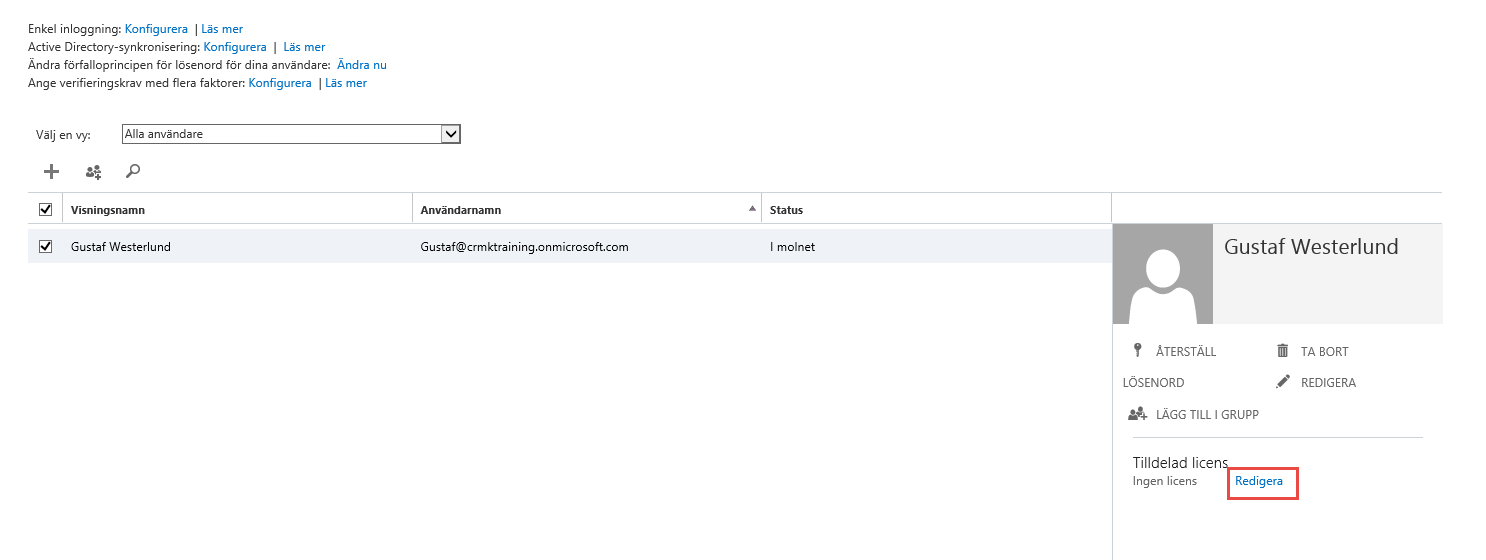 |
| Sorry, this is in Swedish, I tried provisioning Everything in English but the stripes don’t seem to go out… |
To edit the licenses for the selected user, click “Edit” in the pane on the right hand side.
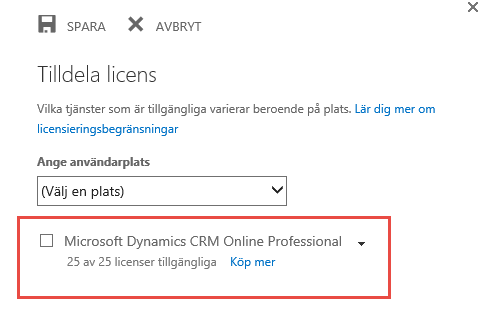 |
| Still in Swedish, it says, “Select License, choose location in the dropdown” |
When you have pressed edit, you are able to edit the licenses for the user, select an appropriate location, and click in the box for Dynamics CRM and press save. Now go back to the user form in CRM, it should be on Another tab.
Scroll to the bottom of the user form and expand the “Administration” tab by clicking on it.
You will now see the Access Mode selector and see that it has been set to “Administrative”.
Change it to “Read-Write”.
If you do not assign a license in the O365 portal, you will see this error in CRM when trying to change the Access Mode.
Remember, that the sitemap has to be reloaded, so press F5 to reload CRM, and as you can see, Everything is turned on now.
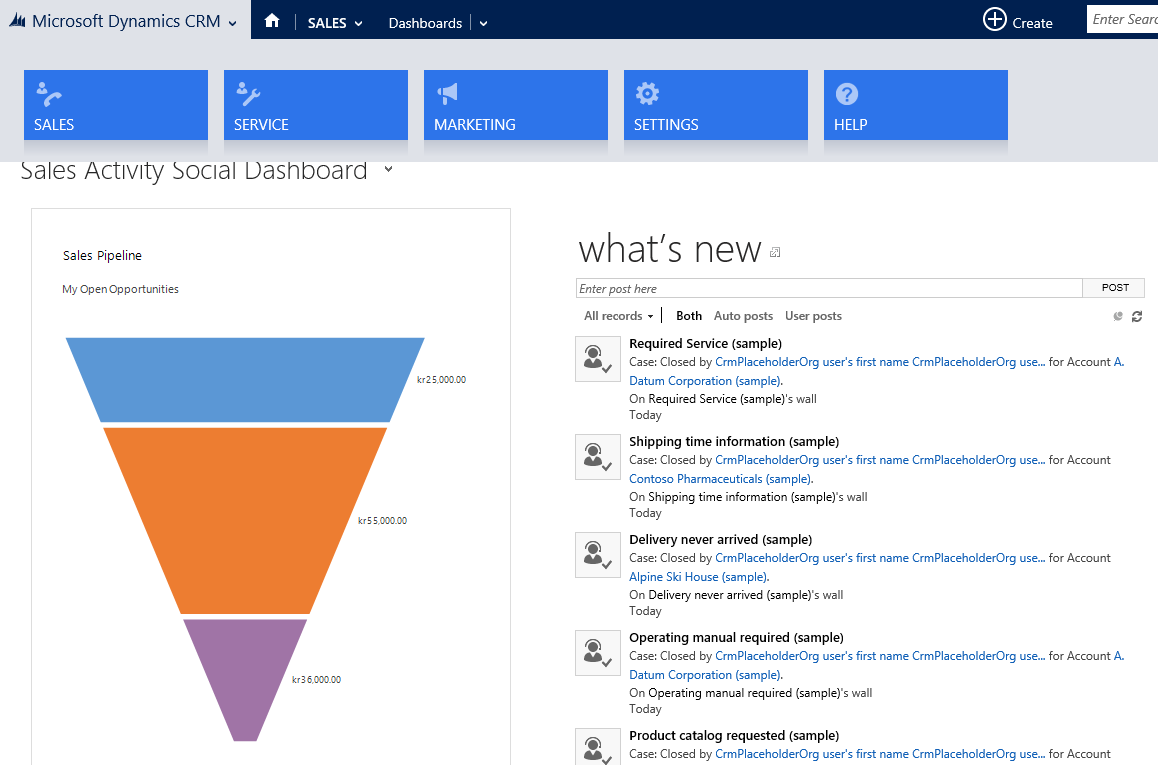 |
| Anybody notice that Microsoft might need to do something about the sampledata? 🙂 |
Good luck!
Gustaf Westerlund
MVP, CEO and owner at CRM-konsulterna AB
www.crmkonsulterna.se
















Recent Comments